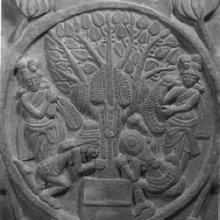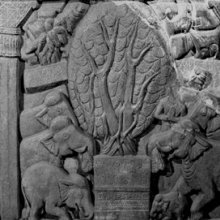Nyagrodha: 26 definitions
Introduction:
Nyagrodha means something in Buddhism, Pali, Hinduism, Sanskrit, Jainism, Prakrit, the history of ancient India, Marathi, biology. If you want to know the exact meaning, history, etymology or English translation of this term then check out the descriptions on this page. Add your comment or reference to a book if you want to contribute to this summary article.
Nyagrodha has 24 English definitions available.
Images (photo gallery)
Languages of India and abroad
Sanskrit dictionary
[Deutsch Wörterbuch]
Source: Cologne Digital Sanskrit Dictionaries: Böhtlingk and Roth Grosses Petersburger WörterbuchNyagrodha (न्यग्रोध):—(nyak + rodha nach unten wachsend) gaṇa nyaṅkvādi zu [Pāṇini’s acht Bücher 7, 3, 53.]
1) m. parox. Ficus indica, ein stattlicher Baum, welcher von seinen Zweigen aus Haarwurzeln in den Boden sendet, die wieder zu Stämmen erstarken. [Amarakoṣa 2, 4, 2, 13. 3, 4, 17, 98.] [Hemacandra’s Abhidhānacintāmaṇi 1132.] [Anekārthasaṃgraha 3, 344.] [Medinīkoṣa.dh. 32.] [Halāyudha 2, 41.] [Atharvavedasaṃhitā 4, 37, 4. 5, 5, 5.] [Vājasaneyisaṃhitā 23, 13.] [Aitareyabrāhmaṇa 7, 30. 31.] [The Śatapathabrāhmaṇa 5, 3, 5, 13. 13, 2, 7, 3.] [Taittirīyasaṃhitā 7, 4, 12, 1.] [Kātyāyana’s Śrautasūtrāṇi 10, 9, 30.] [Chāndogyopaniṣad 6, 12, 1.] [Manu’s Gesetzbuch 8, 246.] [Hiḍimbavadha 1, 24.] [Mahābhārata 3, 2405.] [Rāmāyaṇa 3, 39, 27.] [Varāhamihira’s Bṛhajjātaka S. 28, 3. 50, 17. 53, 96. 85, 81.] [Bhāgavatapurāṇa 4, 6, 17.] Gehört zu den kṣīravṛkṣa [Suśruta 1, 6, 18. 141, 13. 146, 1. 157, 18. 367, 20.] kṣīra [Rāmāyaṇa 2, 52, 62.] —
2) m. ein anderer Baum, s. śamī [Hemacandra’s Anekārthasaṃgraha] [Medinīkoṣa] —
3) m. Faden, das Längenmaass der ausgestreckten Arme [Amarakoṣa 3, 4, 17, 98.] [Hemacandra’s Abhidhānacintāmaṇi 600.] [Hemacandra’s Anekārthasaṃgraha] [Medinīkoṣa] —
4) m. Nomen proprium eines Sohnes des Ugrasena [Harivaṃśa 2028.] [Viṣṇupurāṇa 436.] [Bhāgavatapurāṇa 9, 24, 23.] —
5) m. Name eines nach der Ficus indica benannten Brahmanen, Dorfes und Klosters [Rgva tch’er rol pa] [?(Append.) 416. 425. Lebensbeschreibung Śākyamuni’s, Lebensb. 257 (27).] —
6) f. ī Salvinia cucullata Roxb. [Amarakoṣa 2, 4, 3, 6.] [Medinīkoṣa] ā [Śabdaratnāvalī im Śabdakalpadruma] Nach [Hemacandra’s Anekārthasaṃgraha] ist das f. (ī) auch gleichbedeutend mit vṛṣaparṇī und sohanākhyauṣadhībhid; nach dem [Śabdaratnāvalī im Śabdakalpadruma] ist das m. = viṣaparṇī und mohanākhyauṣadhi; nach [WILSON] giebt [Śabdaratnāvalī] die letzte Bed. dem f. auf ī .
--- OR ---
Nyagrodha (न्यग्रोध):—
4) ein Sohn Kṛṣṇa’s [Bhāgavatapurāṇa 10, 90, 34.] — nyagrodhānvaya [Oxforder Handschriften 19,a,19.]
Source: Cologne Digital Sanskrit Dictionaries: Sanskrit-Wörterbuch in kürzerer FassungNyagrodha (न्यग्रोध):—, niagrodha —
1) m. — a) Ficus indica. — b) *Prosopis spicigera oder Mimosa Suma , . = viṣaparṇī und mohana oder mohanā. — c) Faden , das Längenmaass der ausgestreckten Arme. — d) Nomen proprium — α) eines Sohnes des Kṛṣṇa. — β) eines Sohnes des Ugrasena. — γ) *eines Brahmanen , Dorfes und Klosters (buddh.). —
2) f. ā ([Carakasaṃhitā 7,12]) und ī Salvinia cucullata oder eine andere Pflanze [Dhanvantari's Wörterbuch 1,86.] [Rājan 4,138.] —
3) *f. ī = vṛṣaparṇī und mohana oder mohanā.
Sanskrit, also spelled संस्कृतम् (saṃskṛtam), is an ancient language of India commonly seen as the grandmother of the Indo-European language family (even English!). Closely allied with Prakrit and Pali, Sanskrit is more exhaustive in both grammar and terms and has the most extensive collection of literature in the world, greatly surpassing its sister-languages Greek and Latin.
See also (Relevant definitions)
Partial matches: Nyag, Rodha, Dha, Rota, Ta.
Starts with: Nyagrodhadi, Nyagrodhah, Nyagrodhaka, Nyagrodhakshira, Nyagrodhamula, Nyagrodhamulika, Nyagrodhana, Nyagrodhapada, Nyagrodhaparimandala, Nyagrodhaparimandalata, Nyagrodharaja, Nyagrodharama, Nyagrodharohina, Nyagrodhashayana, Nyagrodhatirtha.
Ends with: Ajapalanyagrodha, Gautamanyagrodha, Plakshanyagrodha.
Full-text (+90): Nyagrodhaparimandala, Nyagrodhika, Naiyagrodha, Nyagrodhaparimandalata, Nyagrodhin, Nyagrodhaka, Nayyagrodha, Kshiravriksha, Nyagrodhapada, Nyagrodhakshira, Bhandira, Pancavalkala, Nyubja, Vishaparni, Vata, Nyagrodhi, Nekkurotam, Gautamanyagrodha, Mulaka, Sthalapadmini.
Relevant text
Search found 78 books and stories containing Nyagrodha, Nyag-rodha, Nyag-rodhā, Nyagro-dha, Nyagrōdha, Nyagrodhā; (plurals include: Nyagrodhas, rodhas, rodhās, dhas, Nyagrōdhas, Nyagrodhās). You can also click to the full overview containing English textual excerpts. Below are direct links for the most relevant articles:
Garga Samhita (English) (by Danavir Goswami)
Verse 5.8.41 < [Chapter 8 - The Killing of Kaṃsa]
Verses 5.8.36-37 < [Chapter 8 - The Killing of Kaṃsa]
Verse 5.12.12 < [Chapter 12 - Pancajana’s Previous Birth]
The Markandeya Purana (by Frederick Eden Pargiter)
Satapatha-brahmana (by Julius Eggeling)
Kāṇḍa XIII, adhyāya 2, brāhmaṇa 7 < [Thirteenth Kāṇḍa]
Kāṇḍa V, adhyāya 3, brāhmaṇa 5 < [Fifth Kāṇḍa]
Kāṇḍa XII, adhyāya 9, brāhmaṇa 1 < [Twelfth Kāṇḍa]
Atharvaveda and Charaka Samhita (by Laxmi Maji)
Treatments of Pittaja diseases < [Chapter 3 - Diseases and Remedial measures (described in Atharvaveda)]
Treatment of Impotency < [Chapter 3 - Diseases and Remedial measures (described in Atharvaveda)]
Treatment of Dental disease and Toothache < [Chapter 3 - Diseases and Remedial measures (described in Atharvaveda)]
Chandogya Upanishad (Madhva commentary) (by Srisa Chandra Vasu)
Sixth Adhyaya, Twelfth Khanda (3 mantras)
General commentary of Sixth Adhyaya, Khandas Eight through Sixteen
Manusmriti with the Commentary of Medhatithi (by Ganganatha Jha)
Verse 2.45 < [Section XIII - Initiation (upanayana)]
Verse 8.246 < [Section XL - Disputes regarding Boundaries]
Verse 8.252 < [Section XL - Disputes regarding Boundaries]
Related products
(+1 more products available)








